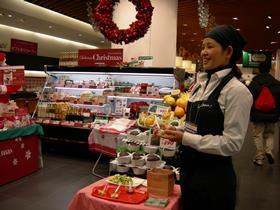
Japan’s fresh fruit import volumes fell by almost 9 per cent year-on-year in 2013 to 1.676m tonnes, according to recently released figures from the country’s Ministry of Finance.
The total marked the second-lowest import volume in 14 years, up only slightly on the 1.658m tonnes of fresh fruit imported in 2007.
The weak yen, which depreciated by around 20 per cent against the US dollar between 2012 and 2013, had a key impact on import trade, according to Junichi Moriya, president of major importer and wholesaler Tokyo Seika.
The total value of imports declared to customs on a CIF basis hit the highest level in 14 years, at ¥195.05bn.
Despite the overall downturn, certain categories witnessed growth and are facing a bright future.
Pineapple imports reached a record a high of 181,000 tonnes (now 10.8 per cent of total fruit imports), as sweet varieties and convenience packs continued to drive consumption. “Higher brix varieties have filtered into the Japanese market, and fresh-cut pineapples have established a strong position and continue to gain popularity,” said Moriya.
Kiwifruit imports also have room to grow once production of sweeter gold varieties rebounds in New Zealand, he believes.
Kiwifruit imports dropped to 59,000 tonnes, from 64,000 tonnes in 2012, largely because supplies from New Zealand were scaled back by the impact of vine disease Psa. “When the supply of gold kiwifruit recovers, it’s estimated that the Japanese market will have the capacity to take 70,000 tonnes of kiwifruit, including green,” said Moriya.
Avocado imports have also been on the rise, especially over the past two years. Volumes leapt by 60 per cent in 2012 to reach 59,000 tonnes, and climbed further to 61,000 tonnes last year. “Consumption is now spreading from the big cities to the regional areas so we can expect to see further development in the future,” Moriya noted.
Despite the gains for certain categories, bananas, which still make up close to 60 per cent of Japan’s total fruit imports, dragged down the overall result. Banana imports dipped below 1m tonnes for the first time since 2007, falling to 975,000 tonnes.
That decline largely reflected the impact of Typhoon Bopha, which hit the Philippines in late 2012, claiming large swathes of production in Japan’s key supply source of Mindanao Island. “Banana supplies were unstable and ran short in 2013, so eventually the import cost went up sharply,” said Moriya.
Despite the cost increases, consumers proved reluctant to pay more for bananas, he added.
“Bananas have been in the Japanese market for many years, and consumers have come to see them as a low-priced fruit. It was concerning to see the consumer reaction when prices were raised at store level.”






No comments yet